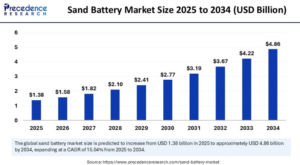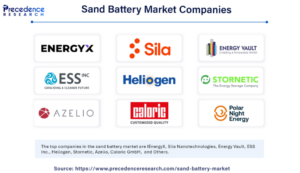According to Precedence Research, the global sand battery market size was calculated at USD 1.2 billion in 2024 and is expected to reach around USD 4.86 billion by 2034, growing at a CAGR of 15.04% from 2025 to 2034.

Key Insights from the Sand Battery Market
- In 2024, North America was the leading region in the global sand battery market.
- Asia Pacific is forecasted to experience the fastest growth during the upcoming years.
- Europe emerged as a major player in the global market.
- The medium capacity (10-50 MWh) segment held a significant share of the market in 2024.
- Silica sand dominated the sand type segment, contributing the largest market share in 2024, and is expected to grow considerably during the forecast period.
- The industrial process heat storage segment led the market by application in 2024.
How Does AI Enhance the Performance of Sand Batteries?
AI plays a pivotal role in optimizing sand battery performance by using machine learning and data analytics to monitor real-time operations. It helps predict potential failures through predictive maintenance, ensuring timely interventions and reducing downtime. AI also manages energy storage efficiently by adjusting parameters like charge rates and temperature, optimizing energy flow, and minimizing waste.
Moreover, AI enhances performance monitoring by continuously tracking the health of the batteries and suggesting real-time adjustments for peak efficiency. In the development phase, AI-driven simulations aid in designing better battery systems by predicting the performance of different materials and configurations, speeding up innovation and improving battery design for larger-scale energy storage solutions.
Revolutionizing Energy Storage: Sand Battery Technology
Sand battery technology uses abundant silica sand to store and release energy, offering a sustainable and cost-effective alternative to traditional battery systems. By harnessing the properties of silicon, these batteries provide high scalability for applications like grid storage, particularly for renewable energy sources. Unlike lithium-based batteries, sand is widely available and environmentally friendly, making it a promising solution for large-scale energy storage. While still in development, sand batteries hold significant potential to transform the future of energy storage by being both eco-conscious and efficient.
Market Scope
| Report Coverage | Details |
| Market Size by 2034 | USD 4.86 Billion |
| Market Size in 2025 | USD 1.38 Billion |
| Market Size in 2024 | USD 1.2 Billion |
| Market Growth Rate from 2025 to 2034 | CAGR of 15.04% |
| Dominated Region | North America |
| Fastest Growing Market | Asia Pacific |
| Base Year | 2024 |
| Forecast Period | 2025 to 2034 |
| Segments Covered | Storage Capacity, Sand Type, Application, and Regions |
| Regions Covered | North America, Europe, Asia-Pacific, Latin America and Middle East & Africa |
Market Drivers
The growth of the sand battery market is driven by several factors, primarily the increasing demand for sustainable and scalable energy storage solutions. As renewable energy sources like solar and wind become more prevalent, there is a growing need for efficient energy storage systems to manage intermittent energy production.
Sand batteries offer a viable solution to this need by providing a stable and eco-friendly way to store large amounts of energy. Additionally, the low cost and abundance of sand, compared to materials like lithium and cobalt, are key drivers pushing the adoption of this technology.
Market Opportunities
The market presents numerous opportunities, particularly in renewable energy storage. As countries and industries focus on transitioning to cleaner energy, sand batteries could play a pivotal role in balancing energy demand and supply. The scalability of sand batteries also opens doors to diverse applications, from residential to industrial-scale energy storage.
Furthermore, research and development in improving the efficiency, capacity, and lifespan of sand batteries could unlock even more applications in sectors like electric vehicles, off-grid systems, and smart cities.
Market Challenges
Despite the potential, the sand battery market faces several challenges. One of the primary hurdles is the current inefficiency and relatively low energy density compared to conventional battery technologies. The technology is still in the early stages of development, and there are concerns about its long-term viability in terms of cost-effectiveness and performance.
Additionally, the lack of widespread infrastructure for manufacturing and deploying sand batteries may hinder growth in the short term. Overcoming these challenges requires continued investment in research and advancements in material science.
Regional Insights
The sand battery market is still in its nascent stage, but regions such as North America, Europe, and Asia Pacific are expected to be key players in its development. North America has already seen significant interest due to its focus on renewable energy adoption and the push for sustainable technology. Europe, with its strong environmental regulations and commitment to renewable energy goals, is another prominent region for sand battery technology.
In Asia Pacific, the fast-growing energy needs, coupled with advancements in energy storage technologies, present ample opportunities for sand batteries to be integrated into the energy infrastructure. Each of these regions will drive innovation and adoption as they look for eco-friendly, large-scale energy storage solutions.
Recent Advancements
- In November 2024, Polar Night Energy revealed plans to build a 1 MW/100 MWh ‘Sand Battery’ for the Finnish energy company Loviisan Lämpö, with the project set to be commissioned in 2025 in Loviisa, Finland.
- In January 2025, Polar Night Energy began searching for a location for its next pilot plant, which will test the Sand Battery’s ability to convert stored thermal energy back into electricity. Construction is scheduled to start in the summer of 2025.
Sand Battery Market Companies

EnergyX: Developing advanced energy storage solutions related to thermal and sand battery technologies.
Sila Nanotechnologies: Focuses on high-capacity battery materials; indirectly supports energy storage innovations including sand battery applications.
Energy Vault: Specializes in gravity-based energy storage using sustainable materials; complements sand battery concepts.
ESS Inc.: Provides long-duration iron flow batteries; part of the broader long-duration energy storage ecosystem.
Heliogen: Develops solar thermal energy systems relevant to sand battery thermal storage principles.
Polar Night Energy: Leading developer of commercial sand battery systems, storing renewable energy as heat in sand.
BrightSource Energy: Expert in solar thermal power and thermal energy storage, aligned with sand battery technology.
SolarReserve: Known for molten salt thermal storage, shares similar thermal storage approaches with sand batteries.
EnergyNest: Creates modular thermal storage systems using concrete; operates on similar heat storage principles.
Stornetic: Offers flywheel energy storage solutions; part of the diverse long-duration storage market.
Azelio: Provides thermal energy storage systems for dispatchable power, similar in function to sand batteries.
Caloric GmbH: Specializes in industrial heat management, relevant to sand battery applications in heat recovery.
Highview Power: Develops cryogenic energy storage; represents alternative long-duration storage technologies alongside sand batteries.









Discussion about this post